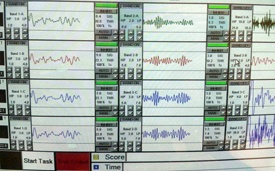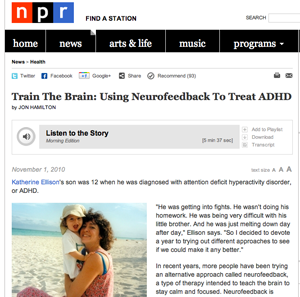Neurofeedback
Brain Training to Improve Daily Life
The better your brain functions, the better YOU function. Plain and simple. The better shape your brain is in, the better you will perform on a day to day basis. In order to live your best life, your brain has to be running at it’s best.
In order to fix any issues in the brain, you have to go directly to the root of the problem. This means going straight to the brain and teaching it how to perform better.
The process is simple. The first step is doing what is called a brain map to pinpoint where in the brain your problems are initiating from. This is recorded using qEEG technology that is later analyzed by a neurofeedback specialist.
The second step is simply relaxing and watching a screen.
The neurofeedback specialist will have analyzed your brain map and developed protocol for your training. All you have to do is watch the screen and relax, and your brain takes care of the rest.
A Parent Explains How It Works:
“When the computer recognizes the brain waves performing correctly it releases a picture of the puzzle and an auditory ding as positive feedback or reinforcement to the brain. This encourages the brain to perform this way again.”
The better the brain functions,
the better YOU function.
What does a typical neurofeedback session look like?
When you arrive, sensors are placed safely and comfortably on the head. These sensors listen to the brain’s electrical activity. The result of this monitoring is called an electroencephalograph, or EEG. The EEG brain waves are very tiny, so this information is digitized and amplified so it can be seen on a computer screen.
The neurofeedback professional sets the computer so it will reward a mix of brain waves that will increase the brain’s healthy brain waves. This reward is called reinforcement.
In this case, the behavior that is being increased is a healthy EEG or healthy brain behavior. When you have the right kind of brain waves, images on the computer screen appear that are pleasant and rewarding. This reward teaches the brain to produce healthier brain waves.
Neurofeedback is the easiest learning you'll ever do.
When more than one location on the brain is being trained at a time, all the locations must make healthy brain waves simultaneously for there to be a reward. Training multiple locations simultaneously increases the brain’s ability to coordinate its activity between locations.
We have found that this healthy coordination, called comodulation, is the best measure of improvement when you do neurofeedback. We check for comodulation changes when we do our follow up brain map.
You relax and watch the computer screen.
Whenever your brain is making better brain waves in all of up to four locations, puzzle pieces come up on the screen accompanied by a sound. You enjoy the change on the computer screen.
While you are looking at the puzzle pieces that have resulted from your brain’s good work, there is a pause that allows your brain to consolidate the learning. Then the cycle starts again and another puzzle piece comes up on the screen as your brain makes healthy brain waves.
Over time, your brain gets better and better at making more healthy and controlled brain waves. You might not be consciously aware of the changes. The neurofeedback professional follows the improvements, helping your brain make more controlled brain waves. Amazingly your brain learns to control your brain waves and your brain works better naturally.
You do not have to do anything to make it work better.
Your brain has learned while you were watching the computer screen. Like learning to ride a bike, your brain does not forget. In fact, your brain keeps improving for quite a while even after you have completed your neurofeedback training sessions.
NPR explains how it works:

Train The Brain: Using Neurofeedback To Treat ADHD from NPR Considering Neurofeedback For ADHD?
A growing number of parents see neurofeedback as an appealing alternative to medication to treat their child’s ADHD. The treatment is relatively simple and painless. First, a practitioner attaches three to 10 electrodes to the child’s head. Each electrode sprouts a lead, or wire, connecting it to a computer. The child sits in front of a screen displaying images that respond to the child’s brain activity. When the child has the right kind of brain activity — the images are rewarding or positive, for example — puzzle pieces might fall into place. Proponents say this helps encourage better behavior over time. Follow this link and listen to “The Story” from the NPR website today November 1st, 2010.
How Neurofeedback Works Even While You're Not Working
Neurofeedback is based on operant conditioning, a way of learning that rewards you for positive or desired behaviors. In other words, when your brainwaves are functioning properly and efficiently, your brain receives a reward in the form of visual and auditory stimulation.
The brain loves rewards and it will try to adapt to functioning at it's best in order to receive this reward. This is repeated to create long-lasting results in how your brain operates.
Who Neurofeedback Can Help
Anyone with a brain! Children, adults, seniors, people all across the lifecycle. People seek neurofeedback for everything from learning disabilities to neurological and psychological challenges as well as performance enhancement in school, work, or sports.
Brain-based challenges can be addressed head on!
Neurofeedback and Medication
Sometimes medications are not an effective treatment and can cause unwanted side effects on top of what you are already struggling with.
Neurofeedback is safe to do if you take medication; it works together to give you the best possible outcome.
Some neurofeedback patients say their reliance on some of their medications was reduced or eliminated.
Performance Enhancement
Get ahead of the game and get an edge on the competition!
Brain training will improve your performance, whether it be in:
- School
- Work
- Sports
- Music
And more!
Neurofeedback will optimize your performance abilities in these key areas.
1. Attention
Being able to paying attention for long periods of time, whether it’s in class or at work, is absolutely vital in performing at your best.
2. Focus
Get down to business, get in the zone, and work putting your best foot forward without being as easily distracted.3. Memory
There are different types of memory that are involved in completing a task, and neurofeedback addresses them all. Memory loss due to aging can also be addressed.
4. Mood
Retraining the brain to function calmly and efficiently provides a lift in how you’re feeling which can result in a sense of relief and greater ease in performing tasks.
5. Sleep
Recharging is necessary to performing your best, so you need to be getting quality sleep in addition to the right amount of sleep.
What happens when these areas are improved upon?
Quality of life improves.
How fast do you notice improvements?
Some people have found improvements even after the first session while for others it takes many sessions of repetition for it to fully take effect. Over the course of about 40 sessions, being seen at least once a week consistently, noticeable improvements occur.
However, it really depends on the individual’s brain, as all of our brains are quite different. What works for one brain may not work for another. Schedule a free consultation with Dr. Jolene Ross to discuss your case.

